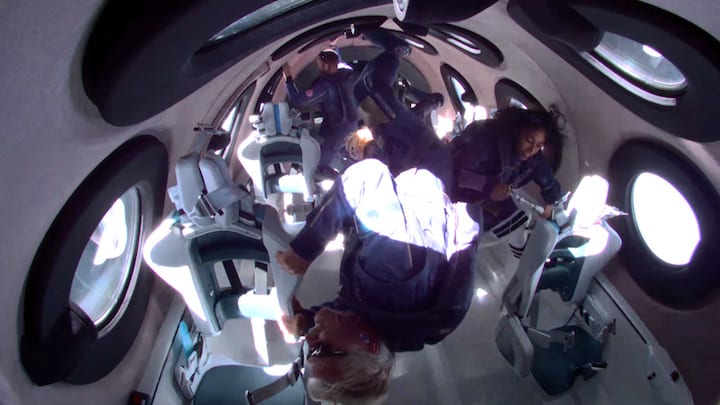Latest News

Richard Branson and Virgin Galactic crew experiencing weightless on the VSS Unity flight on July 11, 2021. Photo: Virgin Galactic
Nearly two decades after founding Virgin Galactic, Sir Richard Branson has made it to space, in a flight that could signify the start of space tourism. Brason was along for the ride when SpaceShipTwo VSS Unity reached space on July 11 in a pre-commercial, test flight.
This was Virgin Galactic’s fourth crewed spaceflight, but its first mission with a full crew. Branson flew with three other Virgin Galactic mission specialists, including Sirisha Bandla, the company’s vice president of government affairs.
VSS Unity achieved a speed of Mach 3 after being released from the mothership, VMS Eve. The vehicle reached space, at an altitude of 53.5 miles, and the crew experienced a few moments of weightlessness. VSS Unity closed the flight by landing at Spaceport America in New Mexico.
“To all you kids down there, I was once a child with a dream, looking up to the stars,” Branson said from the cabin. “Now I’m an adult in a spaceship with lots of other wonder adults, looking down to our beautiful, beautiful Earth. To the next generation of dreamers — if we can do this, just imagine what you can do.”
Virgin Galactic is working to make private space tourism a reality, and last year hired Disney executive Michael Colglazier as CEO. As of its last quarterly results, Virgin Galactic had about 600 bookings for future flights. Those few moments in suborbital space do not come cheap — $250,000 per seat. On Sunday, Virgin Galactic announced a sweepstakes with Omaze to give away two seats on one of the first commercial spaceflights.
“Today is a landmark achievement for the company and a historic moment for the new commercial space industry. With each successful mission we are paving the way for the next generation of astronauts. I want to thank our talented team, including our pilots and crew, whose dedication and commitment made today possible. They are helping open the door for greater access to space – so it can be for the many and not just for the few,” Colglazier said in a news release.
The company has also faced serious setbacks and delays through its development. In 2014, VSS Enterprise vehicle broke apart during a test flight, killing a pilot and seriously injuring another.
In a 2018 interview with Via Satellite, Branson spoke about the challenges of building a space business. “Space projects are obviously difficult. They are some of the most difficult things we have ever taken on, and we have tried a lot of things over the years. Developing new complex things takes time whatever the industry,” he said.
After this flight, Virgin Galactic plans for two additional test flights before it expects to commence commercial service in 2022.
Branson made it to space just days before fellow space billionaire Jeff Bezos plans for a flight on the Blue Origin New Shepard rocket. (Technically, Branson isn’t the first billionaire in space. Software billionaire Hungarian Charles Simonyi visited the International Space Station in 2009, as has been reported.)
It certainly looks like Branson and Bezos are trying to upstage each other, as Branson bumped his flight to space a day after Blue Origin announced that Bezos would fly with aerospace pioneer Wally Funk. After Virgin Galactic’s announcement, Blue Origin pushed hard on the fact that the SpaceShipTwo air-launched vehicle does not pass the Karman line at 100 km/328,083 ft, which is considered by some to be the boundary of space.
In its most recent test in April, the Blue Origin New Shepard crew capsule reached 106 km/347,574 ft above ground level. In Sunday’s flight VSS Unit reached 86 km/282,480 ft. The distance of 80 km/262,467 ft is also recognized, and Virgin Galactic surpasses that distance. Loren Grush of The Verge wrote an excellent analysis of how the boundary is defined in 2018, and how it is under review.
Blue Origin released an infographic ahead of the Virgin Galactic flight, comparing the two experiences in terms of distance, escape system, and even the size of the windows. “From the beginning, New Shepard was designed to fly above the Karman line so none of our astronauts have an asterisk next to their name,” the company tweeted.
Get the latest Via Satellite news!
Subscribe Now